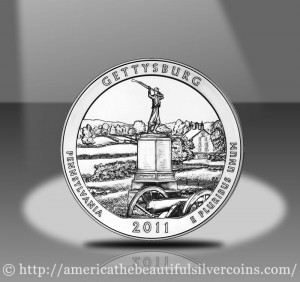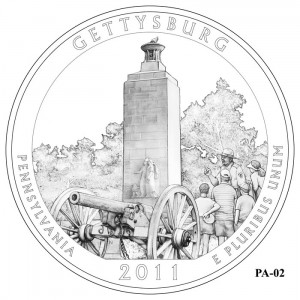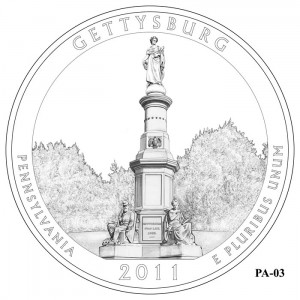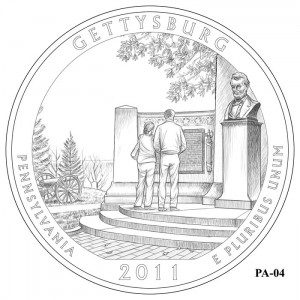The 2011 Gettysburg America the Beautiful Silver Bullion Coin is the sixth .999 fine silver coin released as part of the America the Beautiful Silver Bullion Coin™ Program, but the first to be seen in 2011. This series features five ounce, 3 inch diameter silver bullion coins which duplicate the designs found on the circulating America the Beautiful Quarters.
The United States Mint released the Gettysburg Silver Bullion Coin on April 25, 2011. On that date, the strikes were made available to the Mint’s network of authorized purchasers who were able to order them until May 16, 2011 when the Mint indicated the entire mintage of 126,700 had been sold. The network would then, in turn, resell them to the public for a small premium above the spot price of the silver contained within them.
As on the quarter dollars, a portrait of George Washington (first President of the United States) is featured on the obverse or heads side of the coin. The hefty strike will be edge inscribed with the weight and fineness of the coin.
The reverse or tails side of the Gettysburg coin will be identical to the Pennsylvania 2011 Gettysburg National Military Park Quarter. The US Mint’s description for the design is as follows:
"The Gettysburg National Military Park quarter reverse design depicts the 72nd Pennsylvania Infantry Monument, which is located on the battle line of the Union Army at Cemetery Ridge. Inscriptions are GETTYSBURG, PENNSYLVANIA, 2011 and E PLURIBUS UNUM. The coin’s reverse was designed by United States Mint Artistic Infusion Program (AIP) Master Designer Joel Iskowitz and sculpted by United States Mint Sculptor-Engraver Phebe Hemphill."
For reference, the four design candidates reviewed by the Citizen’s Coinage Advisory Committee and the Commission of Fine Arts for the Gettysburg coin designs are shown below, along with some of their comments.
The CCAC only slightly preferred design number "PA-01" but wanted the US Mint to seek additional designs.
"For the coin portraying Gettysburg National Military Park in Pennsylvania, several members supported design PA-01, which depicts the 72nd Pennsylvania Infantry Monument. However, several members did not support any of the images presented, and most members would have preferred design concepts related to the Battle of Gettysburg and its vital role in American history," stated the CCAC report which will be submitted to to Treasury Secretary Geithner. "The Committee voted 7-2 to encourage the United States Mint to consider soliciting additional designs, perhaps more symbolic in nature, to convey the importance of Gettysburg National Military Park to our Nation."
The CFA chose candidate number three, or "PA-03," but recommended a slight revision to the design
"The Commission recommended alternative #3, commenting that it is the simplest design and will therefore be the most legible at the scale of the coin. The Commission recommended adjusting the lower portion of the design to avoid the awkward relationship of the monument base to the flat portion of the border," the CFA wrote in a letter to Mint Director Ed Moy.
The final decision will be made by the Secretary of the Treasury, as outlined in the America’s Beautiful National Parks Quarter Dollar Coin Act of 2008.
America the Beautiful Quarters and Silver Bullion will feature up to five new designs each year beginning in 2010 through to 2021. Each coin in the eleven year series will have reverse designs that represent a selected National Park or National Site in each state, the District of Columbia and U.S. territories — Puerto Rico, Guam, American Samoa, the U.S. Virgin Islands and the Northern Mariana Islands.
These coins are not sold directly by the US Mint to the public, but instead to a select group of authorized buyers (coin dealers, precious metal providers, etc.) who then resell the coins.
The United States Mint will also be releasing a collector grade version of this coin known as the Gettysburg Silver Uncirculated Coin.
Gettysburg National Military Park in Pennsylvania
Most know the vague history involved with the American Civil War, but few are aware of any of the details. Gettysburg National Military Park in Pennsylvania reminds all of the tragedy inherent in a war of this nature and of a battle which many consider to be a turning point of that war.
Hostilities between the United States of America and the recently seceded Confederate States of America began on April 12, 1861 when the Union held Fort Sumter in South Carolina was attacked by Confederate forces. Since that day, many bloody battles had occurred between the two opposing sides, but none could match the bloodshed that was about to occur near the town of Gettysburg, Pennsylvania.
With several successes under his belt, Confederate General Robert E. Lee took his Army of Northern Virginia through the Shenandoah Valley in order to undertake his second invasion into Northern territory. Not content to let this occur, President of the United States Abraham Lincoln ordered Union forces to stop them and tasked Union Major General George Meade with the responsibility of defeating Lee.
Battle between the two armies commenced on July 1, 1863 when the advanced units of each began to collide. Initial positions of the North were quickly over-run by Lee’s men and Union forces retreated. By the second day, the mass of both armies had arrived with Union soldiers numbering almost 94,000 while Lee’s Army consisted of a bit less than 72,000 men.
With its larger force, the North was better able to defend their lines and despite repeated Southern attacks, they were able to hold their positions. On the third day, July 3, 1863, desperate for a break, Lee ordered an attack on the center of the Union line at a place known as Cemetery Ridge. 12,500 Army of Northern Virginia members advanced, but were repulsed by Union rifle and artillery fire at a great cost to their numbers.
Defeated, Lee had no choice but to retreat back to Virginia, albeit with many less men than he had come with. An estimated 4,708 Southern soldiers lost their lives in the battle with another 12,693 wounded and 5,830 either captured or missing. The North did not fare much better when it comes to casualties. They lost 3,155 with 14,530 wounded and 5,369 captured or missing.
Four months later, President Abraham Lincoln would dedicate Soldier’s National Cemetery located on the battlefield. His "Gettysburg Address", as it has come to be known, is now considered one of the most famous speeches ever given and began with the memorable words "Four score and seven years ago…"
Considered a Northern victory, many historians mark the battle as the turning point for the war which eventually ended with the Confederate States of America surrendering.
Preservation of the battlefield commenced within days after its completion. Local citizens, along with the Governor of the state immediately saw a need not only for a cemetery to bury the dead, but some way to honor the fallen. The Gettysburg Battlefield Memorial Association was created and within a few years, memorials started to be erected.
In 1895, President Grover Cleveland signed legislation to create Gettysburg National Military Park which would be the recipient of 800 acres and 300 monuments that were currently under the control of the Gettysburg Battlefield Memorial Association. Then, in 1933, control was passed to the National Park Service.
Almost 6,000 acres are currently a part of the National Military Park which sees over 1.5 million visitors annually.




